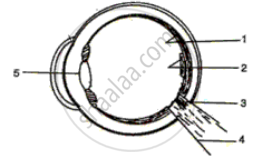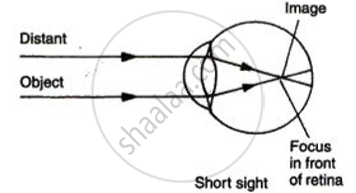Advertisements
Advertisements
Question
The diagram alongside represents a section of a mammalian eye.
(i) Label the parts 1 to 5 of the diagram.
(ii) State the function of the parts labelled 4 and 5.
(iii) With the help of a diagram show the short sightedness.

Solution
(i) 1- Retina
2 - Yellow spot
3 - Blind spot
4 - Optic nerve
5 - Lens
(ii) Optic nerves - It transmits the impulses to the brain.
Lens - It focuses the image on the retina.
(iii) Short sightedness:

APPEARS IN
RELATED QUESTIONS
Name any two defects of vision which can be corrected by using spectacles.
Name one defect of vision (or eye) which cannot be corrected by any type of spectacle lenses.
A student sitting in the last row of the class-room is not able to read clearly the writing on the blackboard.
How can this defect by corrected?
Explain with the help of labelled ray diagram, the defect of vision called myopia and how it is corrected by a lens.
The defect of vision in which the eye-lens of a person gets progressively cloudy resulting in blurred vision is called:
(a) myopia
(b) presbyopia
(c) colourblindness
(d) cataract
The near point of a long-sighted person is 50 cm from the eye.
(a) Can she see clearly an object at:
(i) a distance of 20 cm?
(ii) at infinity?
Enumerate the common defects of vision, their causes and the possible methods of correcting them.
Given below is a diagram depicting a defect of the human eye? Study the same and answer the question that follow:

Draw a labeled diagram to show how the above mentioned defect is rectified using the lens named above.
Name the common defects of the eye.
Name an old age eye defect. Why is it caused?
Name the following:
The defect of the human eye caused due to the uneven surface of the cornea.
What type of lens is used to correct Astigmatism?
The diagram given below represents the cross-section of the human eye:

(i) Name the parts labeled 1—12.
(ii) What is the function of the part marked ‘10’?
(iii) What would happen if part ‘5’ is damaged or cut?
Given below is a diagrammatic representation of a defect of the human eye:

(i) Identify the defect.
(ii) Mention two reasons for the above defect.
(iii) State how the defect can be rectified.
(iv) Name the part of the eye responsible for maintaining the shape of the eyeball.
Due to elongation of _______ and increase in curvature of the eye lens, a person cannot see distant objects clearly.
Differentiate the eye defects: Myopia and Hypermetropia
Observe the figure whether it is correct or not and explain the phenomenon.

Complete the following table by observing the given figures:
| Figure → |  |
 |
| Points ↓ | ||
| (a) Name of the defect | ______ | ______ |
| (b) Position of the image | ______ | ______ |
| (c) Lens used to correct the defect | ______ | ______ |
